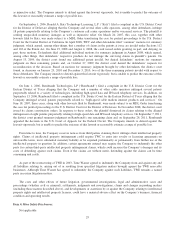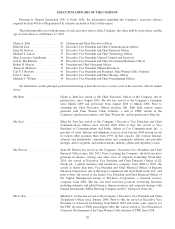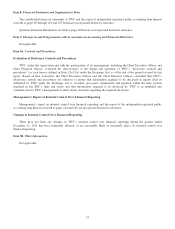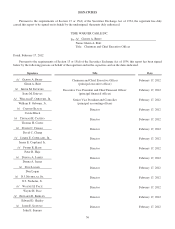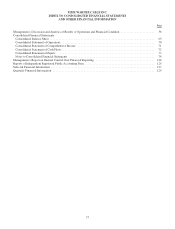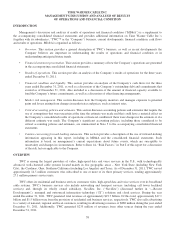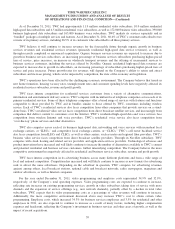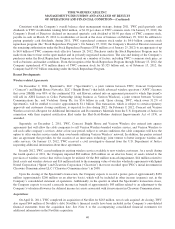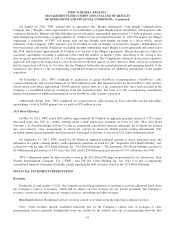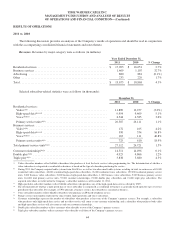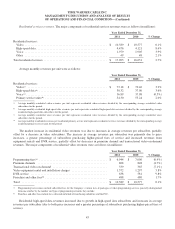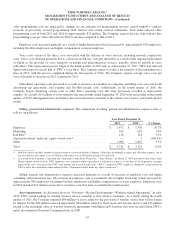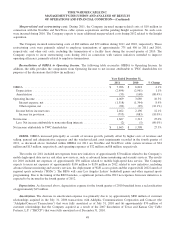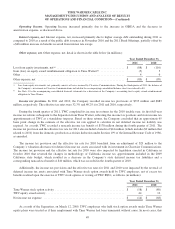Time Warner Cable 2011 Annual Report Download - page 47
Download and view the complete annual report
Please find page 47 of the 2011 Time Warner Cable annual report below. You can navigate through the pages in the report by either clicking on the pages listed below, or by using the keyword search tool below to find specific information within the annual report.TIME WARNER CABLE INC.
MANAGEMENT’S DISCUSSION AND ANALYSIS OF RESULTS
OF OPERATIONS AND FINANCIAL CONDITION—(Continued)
As of December 31, 2011, TWC had approximately 11.9 million residential video subscribers, 10.0 million residential
high-speed data subscribers and 4.5 million residential voice subscribers, as well as 172,000 business video subscribers, 390,000
business high-speed data subscribers and 163,000 business voice subscribers. TWC markets its services separately and in
“bundled” packages of multiple services and features. As of December 31, 2011, 60.4% of TWC’s customers subscribed to two
or more of its primary services, including 26.5% of its customers who subscribed to all three primary services.
TWC believes it will continue to increase revenues for the foreseeable future through organic growth in business
services revenues and residential services revenues (primarily residential high-speed data service revenues), as well as
through recently completed or announced acquisitions. Organic business services revenues are expected to increase due to
growth in business services subscribers, an increasing percentage of business services subscribers purchasing higher-priced
tiers of service, price increases, an increase in wholesale transport revenues and the offering of incremental services to
business services customers, including the services offered by NaviSite. Organic residential high-speed data revenues are
expected to increase due to growth in subscribers, an increasing percentage of subscribers purchasing higher-priced tiers of
service and price increases. Future growth rates for revenues will depend on the Company’s ability to retain and attract
subscribers and increase pricing, which can be impacted by competition, the state of the economy and regulation.
TWC’s operations have been affected by the challenging economic environment. The Company believes that trends in
new home formation, housing vacancy rates, unemployment rates and consumer spending levels have negatively affected its
residential services subscriber, revenue and profit growth.
TWC faces intense competition for residential services customers from a variety of alternative communications,
information and entertainment delivery sources. TWC competes with incumbent local telephone companies across each of its
primary residential services. Some of these telephone companies offer a broad range of services with features and functions
comparable to those provided by TWC and in bundles similar to those offered by TWC, sometimes including wireless
service. Each of TWC’s residential services also faces competition from other companies that provide services on a stand-
alone basis. TWC’s residential video service faces competition from direct broadcast satellite services, and increasingly from
companies that deliver content to consumers over the Internet. TWC’s residential high-speed data and voice services face
competition from wireless Internet and voice providers. TWC’s residential voice service also faces competition from
“over-the-top” phone services and other alternatives.
TWC also competes across each of its business high-speed data, networking and voice services with incumbent local
exchange carriers, or “ILECs,” and competitive local exchange carriers, or “CLECs.” TWC’s cell tower backhaul service
also faces competition from ILECs and CLECs, as well as other carriers, such as metro and regional fiber providers. TWC’s
business video service faces competition from direct broadcast satellite providers. Through its NaviSite subsidiary, TWC
competes with cloud, hosting and related service providers and application-services providers. Technological advances and
product innovations have increased and will likely continue to increase the number of alternatives available to TWC’s current
and potential residential and business services customers, further intensifying competition. The Company believes the more
competitive environment has negatively affected its residential and business services subscriber, revenue and profit growth.
TWC faces intense competition in its advertising business across many different platforms and from a wide range of
local and national competitors. Competition has increased and will likely continue to increase as new formats for advertising
seek to attract the same advertisers. Depending on the advertiser in question, TWC competes for advertising revenues
against, among others, local broadcast stations, national cable and broadcast networks, radio, newspapers, magazines and
outdoor advertisers, as well as Internet companies.
For the year ended December 31, 2011, video programming and employee costs represented 34.9% and 32.9%,
respectively, of the Company’s total operating expenses. Video programming costs are expected to continue to increase,
reflecting rate increases on existing programming services, growth in video subscribers taking tiers of service with more
channels and the expansion of service offerings (e.g., new network channels), partially offset by a decline in total video
subscribers. TWC expects that its video programming costs as a percentage of video revenues will continue to increase.
Additionally, the more competitive environment discussed above may increase TWC’s cost to obtain certain video
programming. Employee costs, which increased 34.3% for business services employees and 3.5% for residential and other
employees in 2011, are also expected to continue to increase as a result of many factors, including higher compensation
expenses and headcount, reflecting the Company’s investment in business services and other areas of growth, as well as the
impact of recent acquisitions.
39


